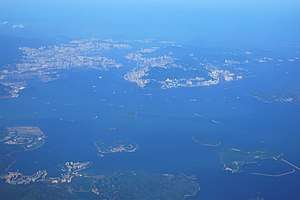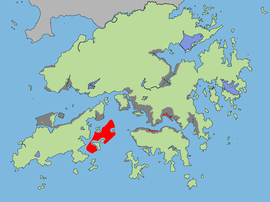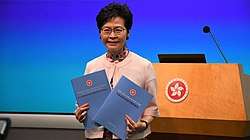Lantau Tomorrow Vision
Lantau Tomorrow Vision (Chinese: 明日大嶼願景) is a development project in Hong Kong launched by Chief Executive Carrie Lam in her 2018 policy address which includes the creation of a third core business district by constructing artificial islands with a total area of about 1,700 hectares through massive land reclamation near Kau Yi Chau and Hei Ling Chau of the eastern waters of Lantau Island.[1] The project has met with controversy and opposition for its high cost of estimated HK$500 billion (US$63.8 billion) – amounting to half of the city's fiscal reserves, as well as environmental concerns.

Background

The idea of the massive reclamation in the eastern waters off Lantau Island was suggested by Chief Executive Leung Chun-ying's policy address in January 2014, where he proposed the strategic studies on artificial islands in central waters for the development of the East Lantau Metropolis (ELM) for long-term land supply.[2]
In 2016, the government published the Hong Kong 2030 Plus project suggesting the development of an East Lantau Metropolis by reclamations in the waters near Kau Yi Chau and the Hei Ling Chau with a capacity of accommodating population of about 400,000 to 700,000 and creating employment of about 200,000.[3] The Sustainable Lantau Blueprint of 2017 and the Task Force on Land Supply adopted the ELM project, in which the Task Force listed it as one of the 18 options in the five-month public consultation in 2018.[4]
During the public consultation of the Task Force on Land Supply, the think tank led by former Chief Executive Tung Chee-hwa, Our Hong Kong Foundation, proposed a research report on 7 August 2018 titled "Re-imagining Hong Kong with a Game-Changer: Enhanced East Lantau Metropolis" of reclaiming 2,200 hectares in the eastern waters off Lantau in 14 years of time which would house 1.1 million people that would solve Hong Kong's land shortage problems.[5] It came after Chief Executive Carrie Lam signaled her support for land reclamation when she said he was confident "that reclamation outside Victoria Harbour is the way to go, adding that she hopes the task force will also come to that conclusion."[6]
Content

On 10 October 2018, Carrie Lam's second policy address laid out the "Lantau Tomorrow Vision" which included the 1,700-hectare reclamation project which would provide between 260,000 and 400,000 homes to 700,000 to 1.1 million people, of which 70 per cent of the homes would be public housing.[7] The reclamation project would create artificial islands near Kau Yi Chau and Hei Ling Chau of the waters of East Lantau.
The reclamation would be consisting of the construction of artificial islands In the pamphlet, the project also suggested expanding the infrastructure capacity to support Lantau's role as a "double gateway" to the world and Yuegang'ao Greater Bay Area, including road and rail connecting the artificial islands and Hong Kong Island and Sunny Bay.
The project, almost double the size of its original proposal, would be the largest and most expensive to date, with a predicted cost of between HK$400 billion and HK$500 billion (US$64 billion).[8] The project also suggested setting up a $1 billion Lantau Conservation Fund to promote and carry out conservation projects on Lantau.
Concerns
The Lantau Tomorrow Vision met fierce opposition immediately after its publication. Roy Tam Hoi-pong of the environmental group Green Sense, expressed his worry that the project would drain the city's coffers, estimating it could cost up to HK$1 trillion (US$128.2 billion), almost all of Hong Kong's fiscal reserves.[9]
Former Hong Kong Observatory director Lam Chiu-ying warned that the reclaimed area would be vulnerable to rising sea levels and extreme weather due to the climate change.[9]
Carrie Lam's announcement of the project was also criticised for pre-empting a report from the Task Force on Land Supply which carried out five months of public consultations and was supposed to advise the government on the best ways to deal with the land shortage as the project only came barely two weeks after the public consultations and before the publication of its final report.[9]
It was also accused of being a gift to private businesses to enable them to make gigantic profits, as a similar proposal by Tung Chee-hwa's Our Hong Kong Foundation was consisting of governors and supporters represent the major developers and powerful insiders including New World, Henderson, Hang Lung, Sino Group, Shui On, Shimao, Shun Tak, Fung Group, Lan Kwai Fong Group, Arthur Li, Elsie Leung, and Bernard Chan.[10]
See also
- Airport Core Programme
- Land reclamation in Hong Kong
- Yuegang'ao Greater Bay Area
References
- "Lantau a development priority". Hong Kong Government. 10 October 2018.
- "Policy Address". Hong Kong Government.
- Hong Kong 2030+ (PDF).
- "Hong Kong vision for huge East Lantau island is a gift to private business and blind to costs of climate change". South China Morning Post. 12 October 2018.
- "Re-imagining Hong Kong with a Game-Changer: Enhanced East Lantau Metropolis". Our Hong Kong Foundation. 7 August 2018.
- "Carrie Lam signals support for land reclamation". RTHK. 1 July 2018.
- "Hong Kong will build homes on artificial islands near Lantau to tackle housing crisis: Carrie Lam". Strait Times. 10 October 2018.
- "In tomorrow's world, Hong Kong's leader sees a massive HK$500 billion artificial island in middle of the sea, home to 1.1 million people". South China Morning Post. 10 October 2018.
- "Hong Kong 'throwing money into sea' with proposed reclamation project for new town, concern groups warn". South China Morning Post. 11 October 2018.
- "Why Lantau reclamation would breed a white elephant, and there's nothing 'unavoidable' about it". South China Morning Post. 21 August 2018.